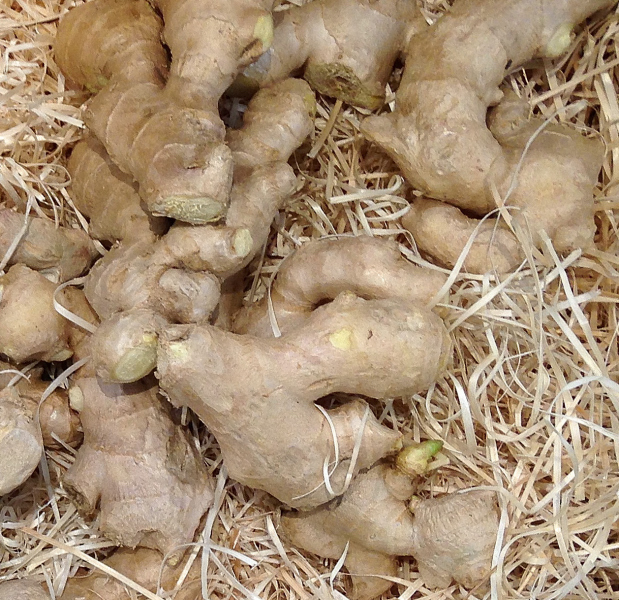The Zingiberaceae family, also known as the ginger family, is a group of tropical and subtropical plants belonging to the order Zingiberales. This family includes around 50 genera and over 1,300 species. Plants from the Zingiberaceae family are widely known for their aromatic rhizomes, which are used in both culinary and medicinal applications. Some famous members of this family include Zingiber officinale (ginger), Curcuma longa (turmeric), and Alpinia.
General Description
Plants in the Zingiberaceae family are typically herbaceous, with erect or creeping stems, and long, narrow leaves. Here are some common features:
- Leaves: The leaves are generally long, lanceolate, and entire along the margins. In many species, the leaves are arranged alternately along the stem.
- Flowers: The flowers are often large, showy, and usually arranged in spikes or racemes. They are typically symmetric and have colorful petals that attract pollinators like bees and birds. Inflorescences can be very attractive, with flower colors ranging from white to yellow, orange, pink, or red.
- Fruits: Fruits are typically capsules or berries that contain numerous seeds. Some species produce fleshy fruits, while others have dry capsules.
- Roots: Plants in the Zingiberaceae family have underground rhizomes, which are modified stems that grow horizontally beneath the soil. These rhizomes are aromatic and are often harvested for use as spices or for medicinal purposes.
Chemical Composition
Members of the Zingiberaceae family contain a variety of bioactive compounds that contribute to their aromatic, therapeutic, and culinary properties:
- Zingerone: Zingerone is an aromatic compound found in Zingiber officinale (ginger), which gives it its characteristic spicy and aromatic flavor. It is also known for its antioxidant and anti-inflammatory properties.
- Curcumin: Curcumin, the active compound in Curcuma longa (turmeric), is known for its powerful anti-inflammatory and antioxidant properties. It is widely used in traditional medicine and as a dietary supplement.
- Oleoresins: The Zingiberaceae family also contains oleoresins that are rich in aromatic compounds, such as terpenes and phenols, which are used to produce essential oils.
- Gingerol: Gingerol is another chemical compound found in ginger and is responsible for its spicy flavor. It also has anti-inflammatory and digestive properties.
Physical Properties
Plants in the Zingiberaceae family are generally characterized by:
- Flowers: The flowers are large, showy, and attractive, with bilateral symmetry and petals that can be white, yellow, orange, red, or pink, depending on the species.
- Leaves: The leaves are typically thick, fleshy, and can be lanceolate, oval, or heart-shaped, depending on the species. Epiphytic orchids, in particular, have leaves adapted to retain moisture.
- Roots: The roots are rhizomes that grow horizontally and are rich in aromatic compounds. These rhizomes are often harvested for use fresh, dried, or processed into powders.
Production and Harvesting
The Zingiberaceae family includes several commercially important plants used for the production of spices and medicinal products:
- Ginger (Zingiber officinale): Ginger is one of the best-known and widely used spices in the world. The rhizome of Zingiber officinale is widely used in cooking and medicine for its aromatic and therapeutic properties.
- Turmeric (Curcuma longa): Turmeric is another widely used spice, especially in Asia, and is famous for its active compound, curcumin, which has numerous health benefits, including anti-inflammatory and antioxidant properties.
- Cardamom (Elettaria cardamomum): Cardamom is used for its distinctive aroma and is widely used in cooking, particularly in desserts and beverages.
Applications
Medicinal
Plants in the Zingiberaceae family are widely used in traditional medicine:
- Ginger (Zingiber officinale): Ginger is used for its digestive properties and to relieve nausea. It is also a well-known remedy for colds and coughs and is used to alleviate joint pain due to its anti-inflammatory properties.
- Turmeric (Curcuma longa): Turmeric is used to treat inflammation, digestive disorders, and to improve heart health. Curcumin, the main active compound in turmeric, is also studied for its potential in treating neurodegenerative diseases and some types of cancer.
- Cardamom (Elettaria cardamomum): Cardamom is used for its digestive properties, particularly to improve digestion and reduce bloating.
Cosmetics
The aromatic and therapeutic compounds in Zingiberaceae plants are also used in the cosmetic industry:
- Zingerone and curcumin are used in skin care products for their anti-inflammatory and antioxidant properties, particularly to reduce inflammation and improve skin health.
- Essential oils of ginger and turmeric are used in perfumery and body products for their distinctive fragrance and soothing properties.
Environmental
Plants in the Zingiberaceae family also play a role in the environment:
- Soil Stabilization: Plants such as Curcuma and Zingiber are used to prevent soil erosion in tropical regions, thanks to their well-developed root systems that stabilize the soil.
Environmental and Safety Considerations
While plants in the Zingiberaceae family offer numerous benefits, there are some considerations:
- Toxicity: Although plants in the Zingiberaceae family are generally safe for use, some species may cause allergic reactions or skin irritations if used excessively. It's important to use them with caution, especially in medicinal preparations.
- Sustainability: Intensive cultivation of species such as turmeric and ginger can lead to the use of pesticides and fertilizers, with potential negative environmental impacts. Sustainable cultivation practices are crucial to ensure the long-term availability of these plants.
INCI Functions
- Antioxidant: Protects the skin from oxidative damage.
- Anti-inflammatory: Reduces inflammation and soothes irritated skin.
- Antibacterial: Helps combat bacteria and other microorganisms on the skin.
- Exfoliant: Promotes the removal of dead skin cells and encourages skin renewal.
Conclusion
The Zingiberaceae family is one of the most important families for the production of spices and medicinal remedies. Plants like Zingiber officinale (ginger), Curcuma longa (turmeric), and Elettaria cardamomum (cardamom) are valued for their therapeutic, aromatic, and culinary properties. Due to their ability to improve digestion, reduce inflammation, and provide antioxidants, these plants continue to be central in traditional medicine, cooking, and the cosmetic industry.
![]() Zingiberaceae
Zingiberaceae 
